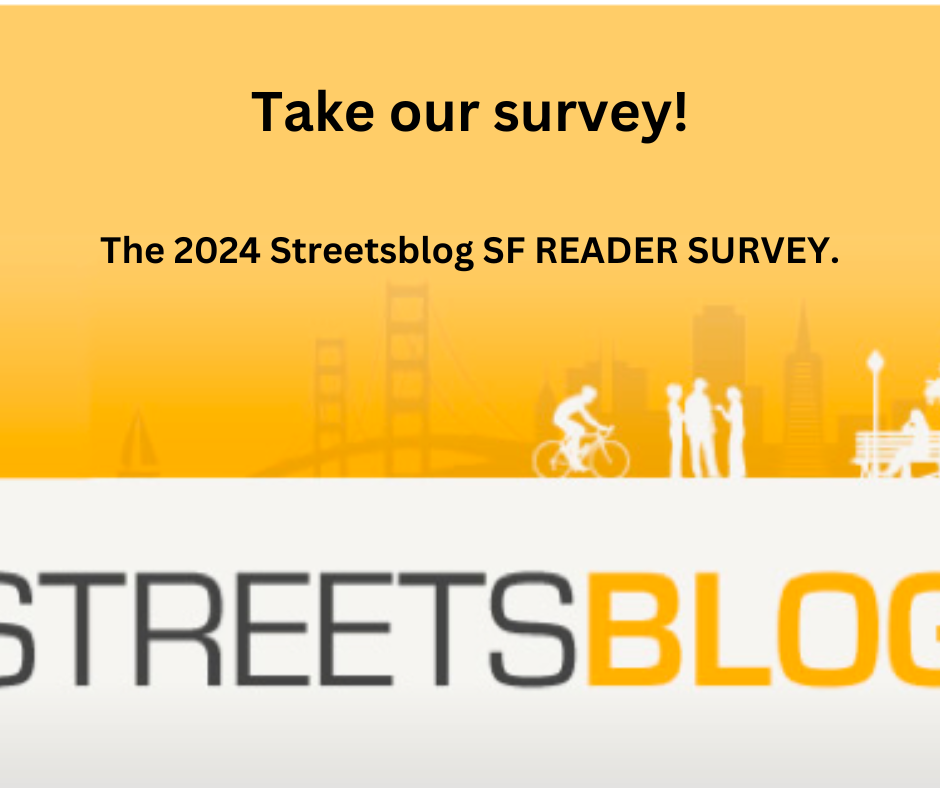Getting More Out of San Francisco’s Carved-up Curbs
9:33 AM PDT on July 14, 2009
 Could cantilevered racks help San Francisco get more out of vacant curbside street space?
Could cantilevered racks help San Francisco get more out of vacant curbside street space?In a city strapped for bike parking and sidewalk space, there is an abundance of one commodity: small strips of curb that seem to be of use to no one. As the lifting of the bike injunction in San Francisco draws nearer, it might be time to consider how these carved-up spots of curbside space can serve a new function.
 Could small strips of curb between driveways, like this one, be turned into parking for multiple bikes? Photo: Michael Rhodes
Could small strips of curb between driveways, like this one, be turned into parking for multiple bikes? Photo: Michael RhodesSuch spaces between driveways range in size, but nearly every block in the city is littered with stretches of curb too small for even the smallest of cars to park. While pedestrian advocates may not be loathe to lose a car parking spot, this does create a zone of sidewalk that lacks a buffer from the roadway, which is normally formed by on-street parking. As Jane Jacobs describes in The Death and Life of Great American Cities, this buffer zone has an essential function for pedestrian comfort and safety
In lieu of engaging in a gargantuan political battle to begin removing driveways, the first step might be to find a better use for the curb space that's left over. After all, unlike nearly anything else in San Francisco, no one else is using it.
Enter the Bike Arc, a curved bike rack that can actually cantilever bikes from the curb into the street. Part hanging system and part roll-up rack, it's designed to save space and make a strong visual impression.
Jeff Selzer, co-founder of Bike Arc, said they're intended as "a way to park a bike, but more like display it." The racks are intended to put bikes "in a place of honor," said Selzer. "A car gets an entire big spot that's just that car's spot. A bike gets a pole to lean up against, or a tree to lean up against. It doesn't really have a spot that's its spot to park." The bike doesn't touch metal at all, except for the lock itself, and so is less likely to get incidentally scratched up.
The Bike Arc does not allow bike owners to lock their front wheel, which is undoubtedly a security drawback. The aesthetic value of the rack, however, means they're more likely to be displayed in a more prominent - and thus secure - place.
"The security starts because the aesthetic is so pleasing that you're willing to put it right front and center," said Selzer. Businesses "have a tendency to put bikes in the back corner," he said, but this design allows them to display the bike rack prominently, "as opposed to hiding it behind."
Marc Caswell, the program manager at the San Francisco Bicycle Coalition, was more skeptical.
"The design,
while eye-catching, seems like a minimal amount of space saved at what
I can only imagine is a much higher cost," said Caswell. "In today's
tough economic times, and the MTA's laudable commitment to over 500
bike racks across the city in the coming year, the simple and
functional U-racks seem like the smart choice here in SF. As long as
cyclists lock parallel to the U-racks on the sidewalk, there is little
pedestrian impediment at a very low cost."
The Bike Arc racks undoubtedly cost more, with the the most basic model costing three times what the city's standard inverted U rack generally runs. For cities looking to brighten up their commercial strips, however, Selzer thinks the Bike Arc is more economical. "They're spending an obscene amount of money to put a bench in, or a new ornate light pole," said Selzer, noting that the Bike Arc might achieve the same goal while also serving an important function for bicyclists.
 Bikes, newspaper stands and utilities jostle while cars have exclusive use of curbside space. Photo: Michael Rhodes
Bikes, newspaper stands and utilities jostle while cars have exclusive use of curbside space. Photo: Michael RhodesIn San Francisco, the real benefit of the Bike Arc rack could be to greater utilize the small strips of curb that are so prevalent on its blocks. On some busy commercial streets, the contrast is striking between the scarce sidewalk space for pedestrians, bike parking, trees, utilities and newspaper boxes and the abundant vacant pavement on the curbside between driveways.
Even a few feet of curb space could accommodate several bikes, and Selzer says a full-size car space can be converted to about 20 cantilevered bike parking spots, while leaving nearly the entire sidewalk for pedestrians. The remaining space between the racks and the traffic lane might even be landscaped, like in the Palo Alto Bike Arc installation pictured above.
In lieu of the Bike Arc, the city might find other creative ways to use the leftover curbside space for bikes, not only freeing up sidewalk space but also filling in some of the buffer zone between the sidewalk and the street, which is so often compromised in San Francisco. With the proper alignment, perpendicular to the curb, even the standard inverted U racks might be able to serve this purpose.
Best of all, making use of these vacant spaces for bike parking could afford great benefits to bikers and pedestrians without requiring a fight to remove existing parking spaces. Of course, with areas like Dolores Park nearly overwhelmed by bicycles on sunny weekend days, even that might be on the table.
Stay in touch
Sign up for our free newsletter



